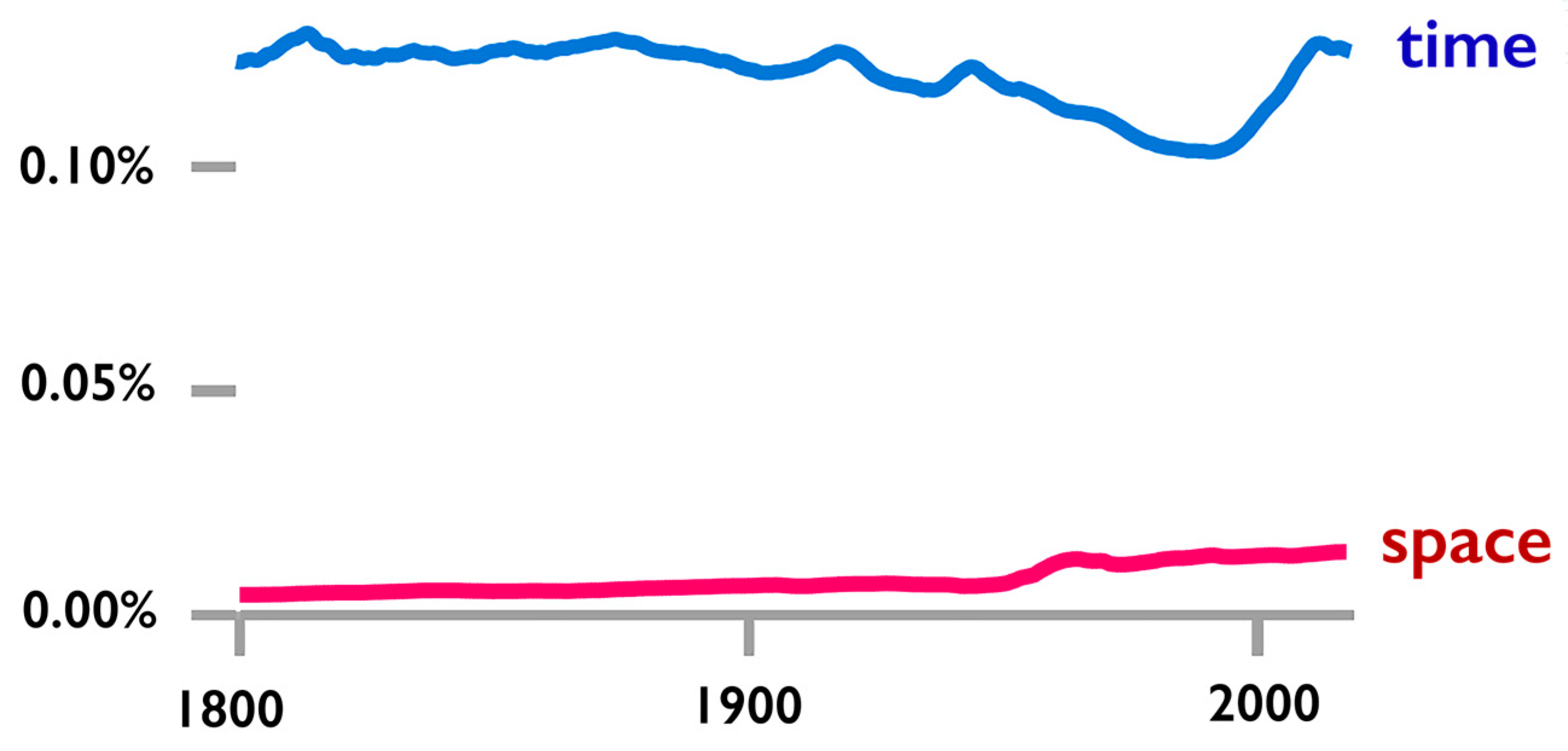Space and Time
Conflicts of Interest
| 1 | As Michael Inwood explains, for Martin Heidegger, for example, “Dasein’s awareness that it will die, that it may die at any moment, means that ‘dying’, its attitude to or ‘being towards’ its own death, pervades, and shapes its whole life.” See [3]. |
| 2 | |
| 3 | |
| 4 | Many cultures have treated time as cyclical, however. See [14]. |
| 5 | The idea of a “body clock” has been around since the 1920s. Although no single temporal nexus has been identified, there is evidence that many cells in the body have their own internal clocks that keep them on approximately twenty-four hour or “circadian” cycles, and that these are regularly resynchronized by a “master clock” in the brain comprising photoreceptive retinal ganglion cells at the back of the eye that control melotonin in the blood via the supra chaismatic nucleus (SCN). On this topic, see [15]. |
References
- Lynch, K. What Time Is This Place? MIT Press: Cambridge, MA, USA, 1972; p. 117. [Google Scholar]
- Nute, K. Embodied Time: Temporal Cues in Built Spaces; Forthcoming; Routledge: London, UK, 2024. [Google Scholar]
- Inwood, M. Heidegger: A Very Short Introduction; Oxford University Press: Oxford, UK, 1997; p. 69. [Google Scholar]
- Pallasmaa, J. Matter, Hapticity and Time. Build. Mater. 2016, 20, 173. [Google Scholar]
- Gentner, D. Spatial Metaphors in Temporal Reasoning. In Spatial Schemas and Abstract Thought; Gattis, M., Ed.; MIT Press: Cambridge, MA, USA, 2001; pp. 203–222. [Google Scholar]
- Nunez, R.; Cooperrider, K. The Tangle of Space and Time in Human Cognition. Trends Cogn. Sci. 2013, 17, 220–229. [Google Scholar] [CrossRef]
- Haspelmath, M. From Space to Time: Temporal Adverbials in the World’s Languages; [Lincom Studies in Theoretical Linguistics 3]; Lincom Europa: Munich, Germany, 1997. [Google Scholar]
- Boroditsky, L. Metaphoric Structuring: Understanding Time through Spatial Metaphors. Cognition 2000, 75, 1–28. [Google Scholar] [CrossRef]
- Pellionisz, A.; Llinas, R. Space-Time Representation in the Brain: The Cerebellum as a Predictive Space-Time Metric Tensor. Neuroscience 1982, 7, 2949–2970. [Google Scholar] [CrossRef]
- Yarrow, K.; Haggard, P.; Heal, R.; Brown, P.; Rothwell, J.C. Illusory Perceptions of Space and Time Preserve Cross-saccadic Perceptual Continuity. Nature 2001, 414, 302–305. [Google Scholar] [CrossRef]
- Teuscher, U.; McQuire, M.; Collins, J.; Coulson, S. Congruity Effects in Time and Space: Behavioral and ERP Measures. Cogn. Sci. 2008, 32, 563–578. [Google Scholar] [CrossRef] [PubMed]
- Roussel, M.E.; Grondin, S.; Killeen, P. Spatial Effects on Temporal Categorization. Perception 2009, 38, 748–762. [Google Scholar] [CrossRef] [PubMed]
- Northoff, G.; Huang, Z. How do the Brain’s Time and Space Mediate Consciousness and its Different Dimensions? Temporo-Spatial Theory of Consciousness (TTC). Neurosci. Biobehav. Rev. 2017, 80, 630–645. [Google Scholar] [CrossRef]
- Eliade, M. The Myth of the Eternal Return: Or, Cosmos and History; Trask, W.R., Translator; Harper Torchbooks: New York, NY, USA, 1959. [Google Scholar]
- Heschong, L. Visual Delight in Architecture: Daylight, Vision, and View; Routledge: London, UK, 2021; pp. 19–35. [Google Scholar]
- Wittmann, M. Felt Time; MIT Press: Cambridge, MA, USA, 2016; p. 124. [Google Scholar]
- Burkeman, O. Four Thousand Weeks: Time Management for Mortals; Farrar, Straus and Giroux: New York, NY, USA, 2021; pp. 4, 23, 26. [Google Scholar]
- Goldstein-Jackson, K. Time: That which man is always trying to kill, but which ends in killing him. In The Dictionary of Essential Quotations; Croom-Helm: London, UK, 1983; p. 154. [Google Scholar]
- Harries, K. Building and the Terror of Time. Perspecta 1982, 19, 58–69. [Google Scholar] [CrossRef]
- Schiffer, I. The Trauma of Time: A Psychoanalytic Investigation; International Universities Press, Inc.: New York, NY, USA, 1978. [Google Scholar]
- Snodgrass, A. Architecture, Time and Eternity: Studies in the Stellar and Temporal Symbolism of Traditional Buildings; P. K. Goel: New Delhi, India, 1990; Volume 1, p. 63. [Google Scholar]

Disclaimer/Publisher’s Note: The statements, opinions and data contained in all publications are solely those of the individual author(s) and contributor(s) and not of MDPI and/or the editor(s). MDPI and/or the editor(s) disclaim responsibility for any injury to people or property resulting from any ideas, methods, instructions or products referred to in the content. |
© 2023 by the author. Licensee MDPI, Basel, Switzerland. This article is an open access article distributed under the terms and conditions of the Creative Commons Attribution (CC BY) license (https://creativecommons.org/licenses/by/4.0/).
Share and Cite
Nute, K. Space and Time. Architecture 2023, 3, 593-595. https://doi.org/10.3390/architecture3040032
Nute K. Space and Time. Architecture. 2023; 3(4):593-595. https://doi.org/10.3390/architecture3040032
Chicago/Turabian StyleNute, Kevin. 2023. "Space and Time" Architecture 3, no. 4: 593-595. https://doi.org/10.3390/architecture3040032
APA StyleNute, K. (2023). Space and Time. Architecture, 3(4), 593-595. https://doi.org/10.3390/architecture3040032




